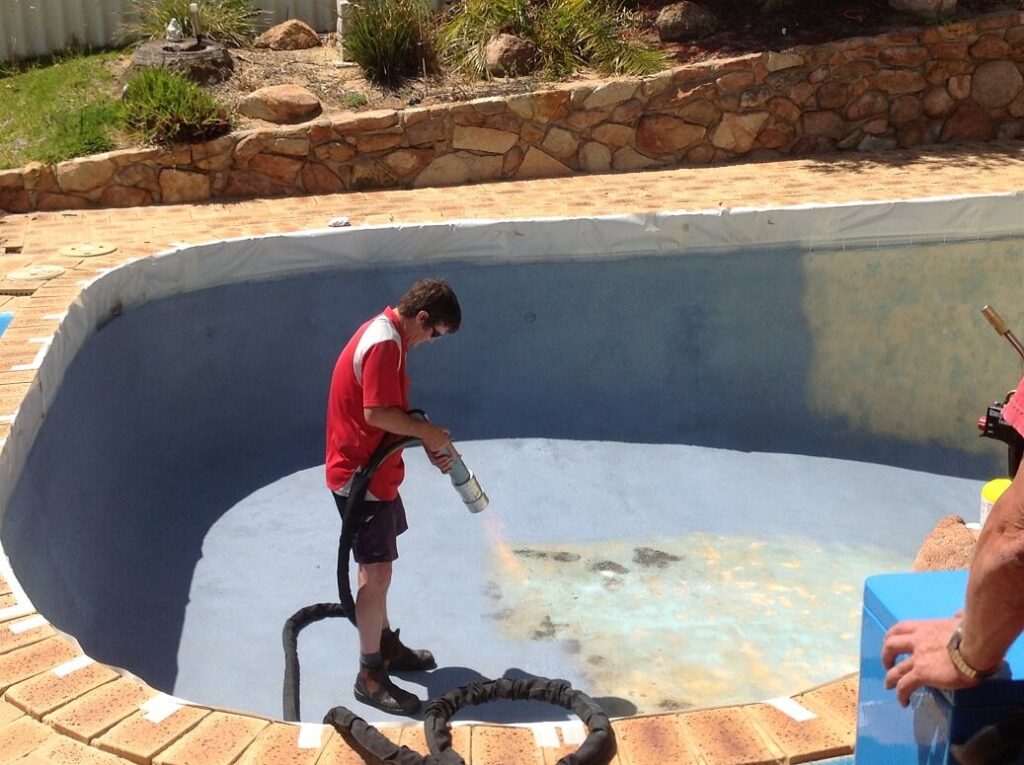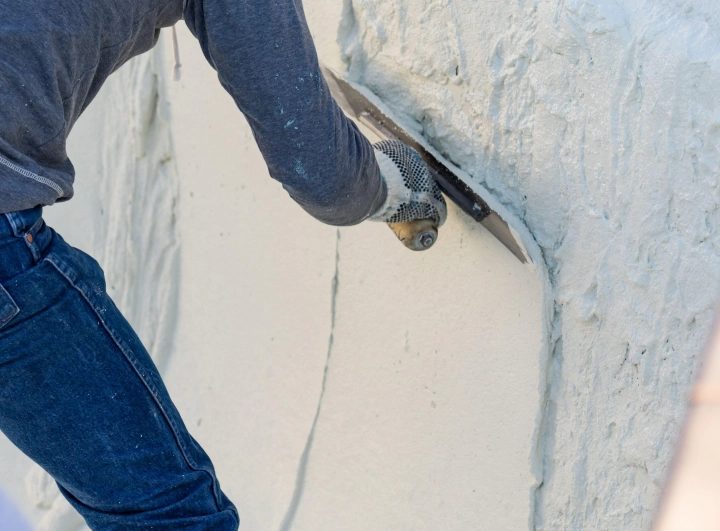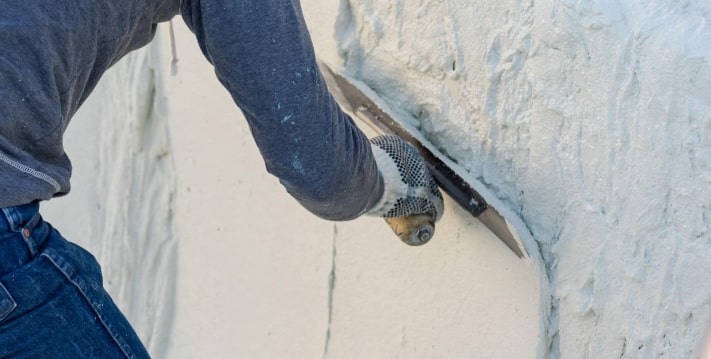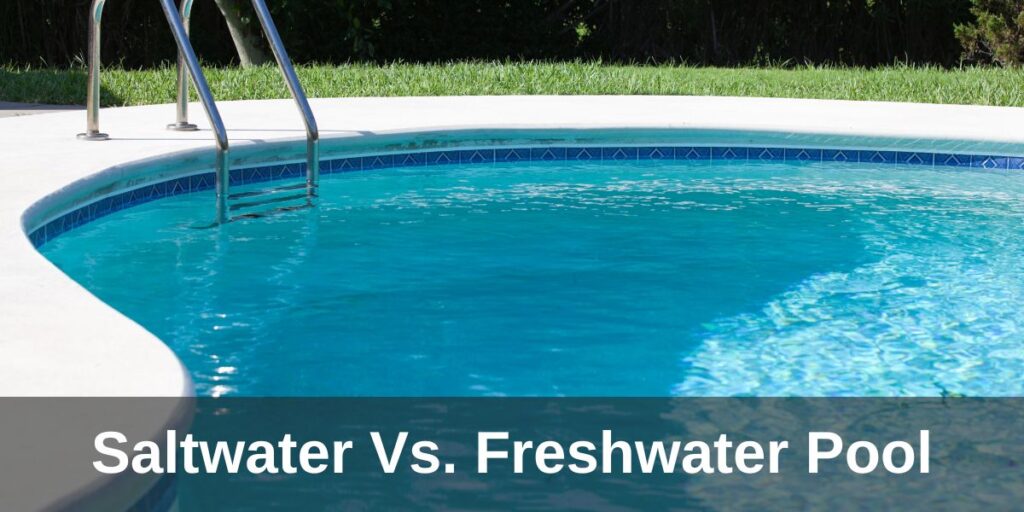For pool owners, understanding the difference between pool resurfacing and replastering is essential not only for maintaining the aesthetic appeal of their pools but also for ensuring structural integrity over time. Many pool owners will eventually face common issues such as surface cracks, discoloration, or leaks, which may necessitate either resurfacing or replastering.
This blog post on pool resurfacing vs. replastering aims to explore these two methods in detail, providing insights into which option might be the best for different types of pools and conditions.
Maintaining a pool goes beyond keeping the water clean; it involves preserving the pool’s structure and appearance. As such, knowing whether to opt for resurfacing or replastering can save significant time, money, and effort, all while ensuring that the pool remains a centerpiece of outdoor recreation.
Pool Resurfacing vs Replastering: The Ultimate Comparison
| Features | Pool Resurfacing | Pool Replastering |
| 1. Purpose | To restore the pool’s aesthetic and structural integrity. | Primarily aimed at enhancing the aesthetic appeal. |
| 2. Material Options | Fiberglass, pebble, quartz, tile, vinyl liner. | Plaster, which may be mixed with quartz or silica. |
| 3. Durability | Varies with material; pebble finishes can last 15+ years. | Traditional plaster lasts 7-10 years before chipping. |
| 4. Cost | Generally more expensive due to diverse material choices. | Typically less expensive than resurfacing. |
| 5. Installation Time | Can take a few days to weeks depending on the material. | Usually completed within a week. |
| 6. Maintenance Requirements | Dependent on the type of material used. | Requires regular maintenance to prevent algae growth. |
| 7. Aesthetic Flexibility | Wide range of colors and textures available. | Limited to the colors and textures of plaster mixes. |
| 8. Best Used When | The existing surface is damaged or needs a style update. | The pool surface has minor imperfections or staining. |

What is Pool Resurfacing?
Pool resurfacing is the process of renewing the surface layer of a swimming pool to address wear and tear, damage, or aesthetic concerns. This is typically required when the existing surface becomes rough, stained, or starts to deteriorate, which can affect both the appearance and functionality of the pool.
The resurfacing process involves several key steps:
- Draining the Pool: The pool is drained to allow for safe and effective access to the surfaces.
- Surface Preparation: The existing surface is cleaned and prepared, often involving the removal of the old surface material. Any cracks or damage are repaired to ensure a smooth base for the new material.
- Applying New Material: The chosen resurfacing material is applied over the entire pool surface. This could include several layers depending on the material.
- Finishing Touches: Once the material is applied, it is smoothed and finished to ensure it is even and aesthetically pleasing.
- Refilling the Pool: After the surface cures, the pool is refilled, and chemicals are balanced for safe use.
For pool resurfacing, several material options are available. Traditional plaster is cost-effective and can be tinted in various colors. Pebble finishes mix plaster with small stones, enhancing durability and aesthetics. Fiberglass offers a smooth, long-lasting surface that resists algae. Tiles, in ceramic or glass, provide superior durability and extensive design options, making them ideal for a customized, high-end appearance. Each material offers unique benefits to meet different needs and preferences.
Benefits of Pool Resurfacing
- Increased Durability: Resurfacing strengthens the pool structure, preventing leaks and extending its lifespan.
- Improved Safety: A smoother surface reduces the risk of injuries from scrapes and cuts.
- Enhanced Hygiene: New surfaces inhibit algae growth and make cleaning easier, promoting better water quality.
- Aesthetic Upgrade: Offers the opportunity to modernize the pool’s appearance, which can enhance the overall look of the property.
- Increased Property Value: A well-maintained, visually appealing pool can significantly boost the property’s market value.
- Customization Options: Resurfacing allows for customization in colors and materials to match personal style or home aesthetics.
What is Pool Replastering?
Pool replastering, often considered a subset of resurfacing, specifically involves applying a new coat of plaster to the pool’s surface. This method is typically recommended when the underlying structure is sound, but the surface layer has deteriorated.
The pool replastering process involves several key steps:
Replastering a swimming pool is a meticulous process designed to restore its surface to optimal condition. Here’s a detailed look at each step:
- Inspection: Thoroughly assess the pool’s plaster surface for damage, including cracks, chips, and areas of thinning plaster.
- Draining: Empty the pool of water to expose the plaster for repair work.
- Surface Preparation: Remove loose or damaged plaster. Sandblast or acid wash the surface to ensure a clean, solid base for the new plaster.
- Bonding: Apply a bonding agent or a layer of bonding plaster. This helps the new plaster adhere better to the existing surface.
- Plaster Mixing: Mix the new plaster to the correct consistency as per the manufacturer’s guidelines.
- Plaster Application: Apply the new plaster using specialized tools to ensure an even coat over the entire surface.
- Smoothing: Smooth the plaster to achieve a uniform texture and finish.
- Curing: Allow the plaster to cure properly, a process that can take several days. Water chemistry should be monitored and adjusted to facilitate proper curing.
- Refilling: Gradually refill the pool, balancing the water chemistry during the filling process to protect the new plaster.
Replastering a pool becomes necessary when the existing plaster shows signs of wear such as cracks, discoloration, or peeling. These issues can compromise the pool’s structure and aesthetic, and replastering helps to restore its waterproof integrity and enhance its appearance. Regular inspections can help determine the right time for replastering.
Benefits of Pool Replastering
- Cost-Effective: Replastering is generally less expensive than full resurfacing because it involves less material and labor.
- Quick Fixes: It is a quicker way to refresh the pool’s look without a complete overhaul.
- Longevity: A properly replastered pool can last many years before needing another treatment.
- Water Chemistry Management: New plaster helps in maintaining balanced water chemistry, reducing the need for excessive chemicals.
- Energy Efficiency: A smooth surface enhances circulation and heat retention, potentially lowering heating costs.
Pool Resurfacing vs Replastering: Key Differences
When deciding between pool resurfacing vs replastering, it’s crucial to understand the key differences and benefits each option offers. Both methods aim to extend the life of your pool but are suited to different needs and conditions.
Lifespan and Durability of Materials:
Resurfacing can involve various materials like pebble, glass beads, or fiberglass, each with a higher durability and typically longer lifespan than the traditional plaster used in replastering. While plaster may last 7-10 years, resurfacing materials can extend beyond 15 years, providing a more permanent solution to pool maintenance.
Cost Comparison:
Replastering is generally less expensive than resurfacing because it uses less costly materials and involves simpler techniques. However, the initial savings may be offset by the need for more frequent replastering. Resurfacing, while more costly upfront, could lead to longer-term savings due to its extended durability.
Suitability for Different Types of Pools and Conditions:
Replastering is suitable for pools that have minor cosmetic issues and require a fresh look. In contrast, resurfacing is ideal for older pools or those with significant structural issues, as it can address deeper cracks and provide a new surface layer that is more resistant to chemicals and physical damage.
Time Required for Each Process:
Replastering typically requires less time compared to resurfacing. A replastering job can be completed within a few days, whereas resurfacing might require a week or more, depending on the size of the pool and the materials used.
Durability:
The durability of resurfaced materials often surpasses that of plaster. Resurfacing provides a tougher barrier against physical impacts and chemical wear, reducing the frequency of future repairs.
Aesthetic Outcomes:
Resurfacing offers more options for aesthetic customization. With a variety of textures and colors available in materials like pebble or fiberglass, pool owners can achieve a more customized and high-end look compared to the more uniform appearance of plaster.
Maintenance:
Maintenance needs may sway the decision. Plaster, while easy to clean, is more susceptible to algae growth and staining. Resurfacing materials are often more resistant to these issues, requiring less frequent intensive cleaning.
Choosing between resurfacing and replastering depends on specific pool conditions and owner priorities. Resurfacing is preferable when the pool requires extensive repair when a complete transformation is desired, or when the owner wants a long-term solution with fewer maintenance demands.
Replastering is suitable when the issues are largely cosmetic, when budget constraints exist, or when the existing pool structure remains in good condition.

Considerations Before Deciding Which Option is the Best
When deciding between pool resurfacing and pool replastering, several factors should be considered to ensure the choice aligns with your needs, budget, and long-term maintenance goals.
Pool Condition: Assessing the current condition of your pool is the first step. If the damage is superficial, such as minor cracks and fading, replastering might suffice. However, for more extensive structural issues or severe surface degradation, resurfacing with more robust materials might be necessary to restore functionality and aesthetics effectively.
Budget: Budget considerations are crucial. Replastering is generally less expensive and can be a cost-effective solution for making cosmetic improvements. Resurfacing, though more costly upfront, offers longer-lasting results and might be more economical in the long run. Evaluating the initial costs versus potential future savings from reduced maintenance needs can guide your decision.
Long-Term Maintenance Goals: Think about your long-term maintenance preferences. If minimal upkeep is a priority, investing in resurfacing might be more advantageous as materials used in resurfacing, such as pebble or fiberglass, are often more durable and resistant to algae and staining compared to plaster.
Local Climate Conditions: The local climate plays a significant role in choosing the right option. In areas with harsh weather conditions, materials used in resurfacing can provide better durability and withstand extreme temperatures and chemical exposure better than plaster.
By carefully considering these factors, you can make a well-informed decision between pool resurfacing vs replastering, ensuring that it meets your specific needs, lasts longer, and remains within your budget.
The Bottom Line
Choosing between pool resurfacing and replastering depends on various factors, including the condition of the pool, desired outcomes, budget, and local environmental conditions. Pool owners should carefully evaluate their situation, perhaps consulting with professionals, to make an informed decision that ensures their pool remains a delightful and safe part of their home for years to come. By understanding the nuances between these two options, owners can maintain their pools effectively, ensuring lasting enjoyment and functionality.
Contact Cutters Pools for Professional Pool Services
Cutters Pools is your premier swimming pool contractor in Austin, Texas, for top-notch professional pool services. Specializing in pool design, construction, maintenance, and repair, we bring your backyard dreams to life with unparalleled craftsmanship and attention to detail. Whether you’re looking to build a new pool, renovate an existing one, or require regular cleaning and maintenance, our team of experts is equipped to handle all your pool needs efficiently and effectively. Call us today to schedule a consultation and experience the best in professional pool care.
Frequently Asked Questions
Q.1 What’s the difference between replastering and resurfacing a pool?
Replastering a pool involves removing and replacing the old plaster coating, primarily addressing surface-level issues like cracks or discoloration. Resurfacing, however, can include replastering or applying new materials like fiberglass or pebble finishes to the entire surface, providing a more comprehensive update to the pool’s durability and appearance.
Q.2 Can you replaster a pool over old plaster?
Yes, you can replaster a pool over old plaster, provided the existing plaster is in relatively good condition. This process involves preparing the old surface by cleaning and possibly repairing any significant damage before applying a new layer of plaster to refresh and enhance the pool’s appearance.
Q.3 What is the cheapest way to resurface a pool?
The cheapest way to resurface a pool is typically by using plaster, especially white plaster. This material is cost-effective compared to alternatives like pebble or fiberglass finishes. It provides a refreshed look while being relatively durable, making it a budget-friendly option for pool resurfacing projects.
Q.4 How long does pool resurfacing last?
The longevity of pool resurfacing depends on the material used. Plaster surfaces can last 5 to 10 years, fiberglass around 15 to 20 years, and aggregate finishes like pebble can last over 20 years. Proper maintenance and water chemistry balance significantly extend the life of the resurfaced pool.



